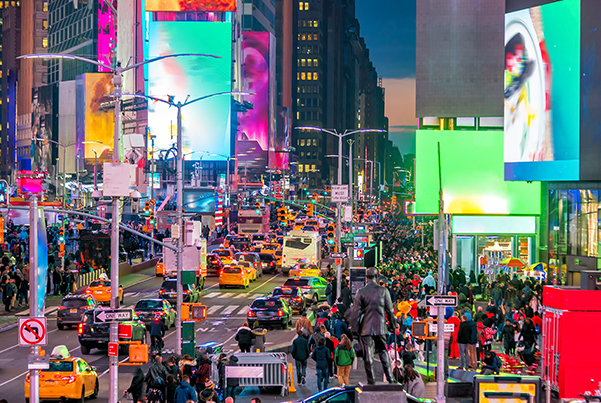Making Dynamic Digital Signs Work for You
Anybody who has watched a big-time college or professional sporting event has seen the real-time effectiveness of dynamic digital signs. After a player scores a touchdown, sinks a big three-pointer, or hits a home run, everybody in the stadium or arena, including the players, looks to the gigantic video monitors to watch the replay. And during breaks in the action, those same screens pump out entertainment or advertise the team and its sponsors. Retail merchants are now harnessing that attraction with smaller video displays to enhance customer service, and those who aren’t utilizing that amazing technology are disappearing as quickly as cathode ray tubes.
Dynamic digital displays have been around for decades. Sony debuted its JumboTron at the 1985 World’s Fair in Tsukuba, Japan, and they’ve only gotten bigger and better. The largest current dynamic display in the NFL – 277 feet by 52 feet – is at NRG Stadium, home of the Houston Texans. However, its 14,548-square-foot screen is minuscule compared to the Fremont Street Experience in Las Vegas. It has the largest screen in the U.S. at 135,000 sq. ft. stretching roughly five football fields in length.
 New York’s Times Square is probably the most recognizable location for dynamic digital signs. It’s seven screens, with approximately 8 million pixels, bombard roughly 1.5 million visitors daily with nonstop dynamic advertising, which shows how effective video messaging can be.
New York’s Times Square is probably the most recognizable location for dynamic digital signs. It’s seven screens, with approximately 8 million pixels, bombard roughly 1.5 million visitors daily with nonstop dynamic advertising, which shows how effective video messaging can be.
Another over-the-top example of digital display advertising can be seen in Los Angeles along Interstate 405 – or “the 405” as Angelinos call it. Wow Media has deployed four 1,200-square-foot digital billboards which are seen by approximately 379,000 motorists daily. It’s easy to question the logic of putting large video monitors adjacent to an L.A. freeway where motorists fly along bumper-to-bumper at speeds well over the posted limit. However, using a dynamic digital sign to stop foot traffic in a retail store is a great idea and it’s not life threatening. It’s also a growing trend with brick-and-mortar merchants looking to capture the attention of their customers.
Orbis Research, a leading market research company, says the digital signage market is expected to grow to more than $31 billion by 2023. Improvements in technology, an expanding market, and a drop in the price of hardware and software have keyed the rapid growth.
Dynamic Retail Experiences
A study a few years ago by FedEx Office determined that eight out of 10 shoppers enter a store because of its signage, and 68% of them purchased a product because a sign caught their eye. A separate study by Nielsen shows that four of five product brands experienced up to 33% of additional sales by using digital signs. Although both studies were done prior to the proliferation of dynamic digital signs, their results show that people are attracted and influenced by pertinent, well-produced digital messages.
How does that benefit retail merchants?
It can turn window shoppers into customers. Video attracts attention. Sports bars are perfect examples of how customers can be captured and retained by relevant video presentations.
Retail brands like Macy’s, Sephora, Nike and Home Depot use dynamic digital signs in their flagship stores to attract, entertain and even assist shoppers. The Home Depot’s Appliance Finder features an interactive touch screen that allows customers to search for and compare large home appliances.
Dynamic digital signs enhance a company’s brand perception.Using lifestyle content, celebrity endorsements or video slideshows can connect stores and their products to customers.
Video content helps merchants connect with their customers. Studies show shoppers today are seeking the same personalization they find online in their favorite brick-and-mortar stores. They want interaction, product recommendations and loyalty rewards. In-store dynamic digital signs can provide product information and expert recommendations which make that personal connection with shoppers.
What’s on TV
There are many ways to use dynamic digital signs inside a store.
Welcome mats or boards are often the first critical impression customers get of a business. Many retailers are using them to welcome shoppers with video that showcases a company’s brand message. They are also the first attempt of merchants to strike a personal relationship with customers.
Product advertising is the most obvious and common use of in-store digital signs. Streaming video displays can show an endless number of products, especially compared to traditional static signs.
“Our most recent Millward Brown study shows that the No. 1 requested content is the ‘what’s on sale’ videos that we created,” Dominick Porto, CEO of Impax Media, told Forbes. “Beyond supermarkets, we believe the same positive impact could be achieved in retail environments where customers are semi-captive (Lowes, Home Depot, or large pharmacy chains) in a checkout line and would appreciate shopping-related content.”
The Millward Brown study shows that consumers are most interested in viewing:
- What’s on sale – 76%
- Weather – 75%
- Upcoming store events – 69%
- New store services – 65%
- What’s happening in their community – 64%
Video demonstrations are a popular way for merchants to enlist industry experts in showing customers how to use products they might buy. This kind of digital content can complement your sales staff’s efforts and reinforce their recommendations to customers.
Customer kiosks are growing in popularity with shoppers who want to help themselves when they’re in a store. Interactive touchscreens allow them to browse products that might not even be on the shelves but are available to be shipped.
Menu boards are perfect for restauranteurs who can cycle through breakfast, lunch and dinner offerings on the same digital sign. They not only display menu options, but they can also serve up photos of the scrumptious food.
“Infotainment” is another aspect of digital display being used by retailers. Doctors and dentists have used television entertainment in their offices for years, reducing the perceived wait time for appointments. Large grocery store chains and even gasoline filling stations are now streaming entertainment content – news, weather and sports – to customers waiting in checkout lines or at self-service gas pumps.
Advantages of Dynamic Signs
It’s not much of a competition when comparing a high-definition dynamic digital display to static printed signs. However, there are many factors merchants need to consider before bringing dynamic digital signs in their stores.
Cost-effectiveness wouldn’t seem to be a strength of digital signage compared to paper and ink. But when you consider the cost of production and printing static signs, and how many times they need to be changed, an investment in a dynamic digital sign system could be a wise move.
Impact is one of digital signage’s most obvious strengths. Walk into any consumer technology store and what’s the first thing you see? The wall of gigantic flat screens displaying ultra-high definition images of exotic locations, synchronized advertisements, or the latest football game. For a retail merchant, a well-placed monitor can work like a bug light, attracting shoppers like flies.
Flexibility is another advantage that dynamic digital signs have over print. Video content can be changed in seconds with a couple of strokes at a computer keyboard. Prices can be adjusted and items can be added or removed from a slideshow quickly and easily.
Customer interaction is something that is gaining traction in many industries. McDonald’s has begun rolling out kiosks that allow customers to place their orders and pay without talking to a server in all 14,000 of its restaurants. Outdoor retailer REI has adopted in-store kiosks that offer internet services to customers for product research, inventory search and price comparisons. Likewise, Nike has interactive touchscreens in some of its larger stores that customers can use for product research and customization.
Many retail technology companies offer software and hardware that can link through a merchant’s point of sale system to provide product promotional videos or YouTube content quickly and easily. Businesses of all sizes are taking advantage of the new technology.
La Pine Ace Hardware is one such store. Despite its rural location in Central Oregon and its market as a dominant regional building supply company, its owners felt increasing competition from big-box stores and online giants such as Amazon. The store implemented EZ-AD TV to digitize its in-store advertising through its point of sale system to combat the threat.
“We get a lot of customers who come in here and compare our prices with Home Depot. Before we would go to our computers and call up their prices. Now we can call up competitors’ prices on our phones and show customers that maybe their prices were lower last week, but not this week,” explains Assistant Manager Cindy Sawyer. “Running our advertising through the monitors works better, too. Instead of printing out all those ads, people can go to the monitors and see what’s on sale. To me, it’s much more of an advantage. It’s the way business is running these days.”
They also use the in-store monitors to demonstrate new products and offer tips on DIY projects.
Signs of the Times
Whether you have a mom and pop curio shop or a string of stores doing millions of dollars a year, dynamic digital signage can help you attract customers, inform and entertain them, all of which can improve your bottom line.
Brian Bullock
Author


